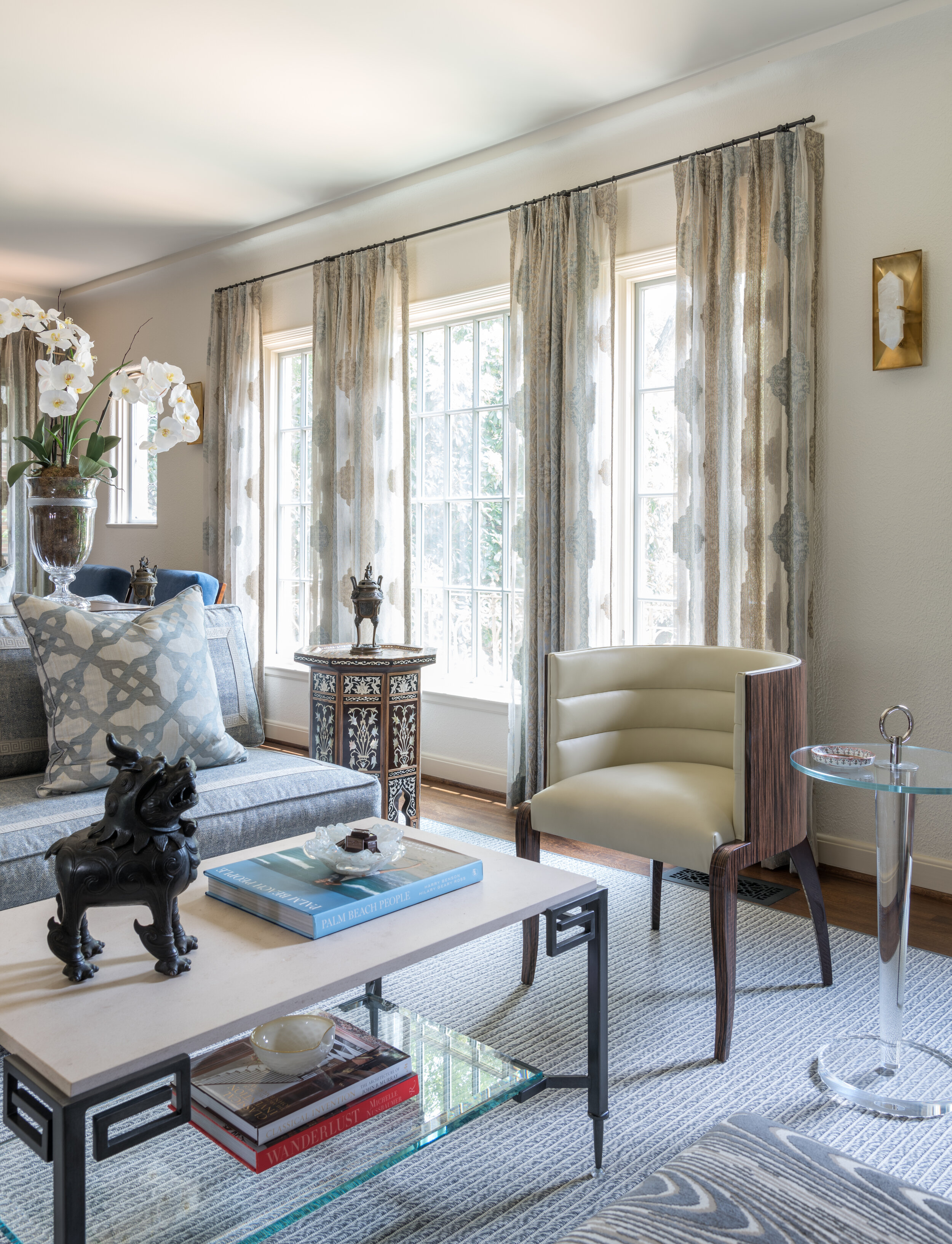This living room is from a home we recently designed in Bent Tree (north Dallas).
Living rooms can be challenging to design because they need to be so many things: inviting, comfortable, stylish, and functional all at once. Pristine living rooms that are only for entertaining guests are now a thing of the past. These days, it’s more common to have the living room be both a family space and an entertaining space.
As a designer, I’m also starting to see living rooms be combined into other spaces, including music rooms, studies, and libraries. A good-size room can even be all of these things. Whether you’re updating your home or moving into a newly built one, it’s helpful to think seriously about all the different ways you plan to use your living room.
A bright pink velvet sofa is the star of this living room in a Park Cities English cottage.
Tip 1: Start With the Sofa
The best place to start is with the sofa. Sofas can make or break a room, so if your existing sofa is not the right style for the room you want, or not the right size for your space, unfortunately you’ll probably have to replace it. Take the time to plan your layout first, as buying the wrong sofa is an expensive mistake. Sofas available through designers tend to be built to last longer than those available from mainstream retailers. Another thing to keep in mind is that simple sofas are easier to style than ones with ornate details.
Tip 2: Use the Rule of Thirds
An easy way to make sure the major elements of your living room are balanced against each other is to follow the rule of thirds. For example, your sofa should generally be two-thirds the width of your area rug, and your coffee table should be two-thirds the width of your sofa. While your major furnishings should be timeless in style, you can safely follow trends for smaller pieces like throw pillows, as these probably won’t be a long-term investment.
This zebra rug adds an element of surprise to the living room for this Dallas ranch home we designed.
Tip 3: Choose the Right Rug Size
Most living room rugs will need to be 9-by-12-foot, 10-by-14-foot, or 12-by-15-foot for a large room. If you have a small room and are having trouble finding a rug that’s just the right fit, try a rug with an unusual shape, such as a zebra rug. These kinds of “amorphous” rugs can fit into a variety of spaces.
Tip 4: Contrast Light Against Dark
The walls of this Plano home are all painted grey. We used black and white accents to create more drama in each room.
A living room that’s all-white can seem too formal and cold. Meanwhile, an all-dark living room tends to feel cave-like, which is an ambiance you might want for your bedroom but not for entertaining guests. The safest color scheme is in the middle: a living room with both light and dark elements.
Tip 5: Shop for Durable Fabrics
If you have young children or pets, you’ll definitely want to choose durable fabrics, such as outdoor fabric lines or Crypton. You should also steer clear of white fabrics that show stains. It’s easy to wipe away spills on leather, but leather also scratches easily, which is something to consider if you have pets.
Tip 6: Mix Old and New
To give your living room some character, try mixing both new and old items. I personally always incorporate antiques into my designs. Including antiques or vintage items is a surefire way to avoid the “showroom” look. Also, mixing different kinds of seating not only makes your living room more interesting, but also gives guests different seating options for their comfort. Make sure to plan your seating around creating conversation groups, rather than have all of the seating facing the TV. Ottomans are one of my go-to’s for extra seating.
Tip 7: Blend Your TV Into The Room
TV’s are a reality of modern life (and sometimes even the focal point in living rooms), so you’ll need to plan around yours. A TV stand is a common solution, but some alternatives you may not have considered include: projecting onto a blank wall, placing a flatscreen TV on a wall and surrounding it with artwork in black frames, or concealing the TV in a large cabinet.
We mixed modern furnishings (art deco chairs) and antiques (incense burners and foo dog statues) in this living room.
If there’s one room in your home that you really need to get right, it’s the living room. Not only does it shape the way guests see your home, but it’s a room you’ll want to enjoy for yourself, too. Regardless of whether you want your living room to be formal or casual, it’s worth your time to plan a space that’s welcoming for family and friends alike.
Of course, not everyone has the time to plan their living room design in detail. Hiring an interior design firm is the best way to ensure your home has that professionally designed touch. Schedule a free consultation with Chambers Interiors by emailing us at info@chambersinteriors.com or calling our Dallas office at 214-651-7665.










